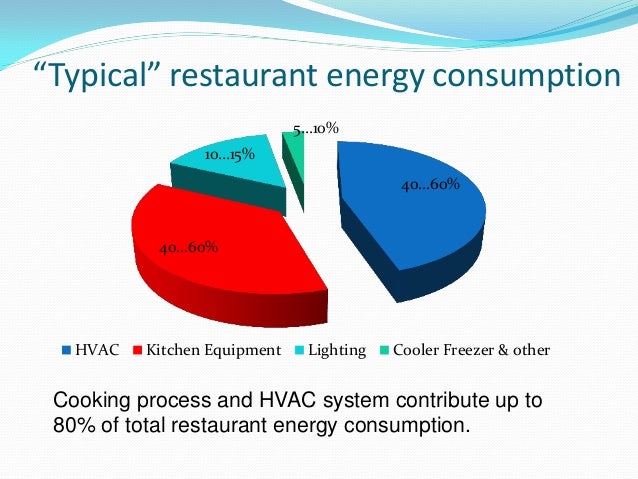
Image source: https://image.slidesharecdn.com/energyefficientsolutionsforcommercialkitchenventilation-150720205612-lva1-app6891/95/mutfak-havalandrmasnda-enerji-verimli-zmler-6-638.jpg?cb=1437426006
Working hard is an efficient way of guaranteeing success, but working smart is the surest way of saving money. The commercial kitchen is one of the major energy consumers in a restaurant. Food preparation represents approximately 30% of a restaurants annual budget. Commercial kitchen equipment such as the refrigeration units, meat processing equipment, food processing equipment, commercial kitchen range, vent and exhaust hoods, water heaters, heating and air conditioning are the main energy guzzlers. These costs are necessary and increasing annually at a rate of 6-8%, but with the right measures, can be minimized and save a lot of money. Below are some of the energy saving tips that you can undertake and increase efficiency in your kitchen while saving a staggering amount of money and protect you from inflation.
Use of energy efficient equipment
The number of energy efficient commercial kitchen equipment is increasing. Your kitchen should be equipped with this high-efficiency equipment to cut down on costs and conserve energy. A typical restaurant can save up to $15000 annually by installing the energy saving appliances.
Audit and Monitor
Regularly get an assessment of your restaurant kitchen equipment. Record the energy consumption of the kitchen and set reasonable targets for reduction. Monitor the electricity, gas and water consumption separately to measure usage and look for areas that can be improved to maximize conservation. For large, power consuming appliances, you can install individual meters to monitor. If you notice changes in the amount of energy usage, it could mean that the equipment requires maintenance. These steps will help you monitor the efficiency of each aspect of the restaurant.
Maintain your equipment
Besides using the right commercial kitchen equipment, maintenance is critical for the safety reasons and for the efficient running of kitchen equipment. Ranging from kitchen equipments, food packaging machines, and other equipment, the best way to handle them is scheduled maintenance. Clean the equipment regularly, install new air filters whenever necessary and check gaskets and seals regularly to maintain energy efficiency as well as to ensure the longevity of the equipment. Most equipment comes with their service manual with recommended maintenance and cleaning schedules.
Conserve hot water
Conserving hot water will help lower two of your utility bills: the heating bill and the water bill. Use of cold water whenever possible will reduce the heating bill. Dish racks use the same amount of water to wash even when not fully loaded, thus is it advisable to always fill it up while washing. Do not thaw food under running water. Instead, put the food in the refrigerator to thaw. Insulate hot water pipes and regularly check the water temperature to ensure everything is working efficiently. If you notice water leaks, have it repaired immediately since even the smallest of leakages can lead to a huge water bill.
Air conditioning
Many may take it for granted because it is invisible, but air in your commercial kitchen impacts a lot on the efficiency of the kitchen equipment. Heating, ventilation and air-conditioning accounts for up to 28% of a modern restaurants energy expenses. With energy efficient solutions, you can save thousands of dollars annually. You should invest in an energy efficient air conditioning unit and ventilation hoods, as well as a programmable thermostat, to turn off the air conditioner when it is not needed. Ensure the ventilation hoods are always properly cleaned. Grease and dirt can build up in the unit and cause it to require more energy to work.
Reduce appliances' operating hours
Eliminate idle time for all appliances and conserve energy. Only use what you need when you need it. Only turn on heating and cooking equipment a few minutes before you begin using it. 10-20 minutes should be enough for the equipment to preheat. Invest in appliances that have sleep-mode capability. While in sleep-mode the appliance consumes less power, but it can still be turned on quickly when needed. Lights, hoods, signs, ranges and fans should all be turned off when not in use.
Rearrange your kitchen
Separate your cooling equipment from your heating and cooking equipment. Cooling equipment will use more energy around hot appliances, so grouping the heating appliances together will save energy. The heating equipment should also be as close as possible to ventilation units.